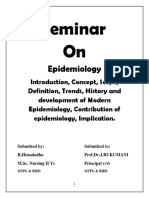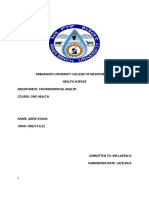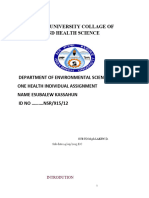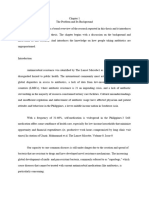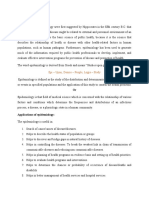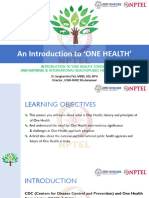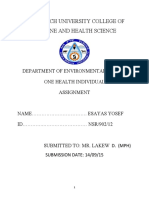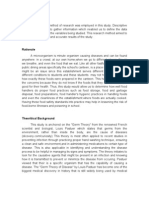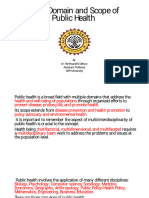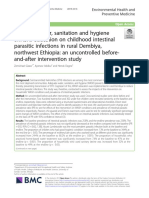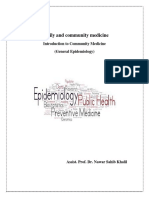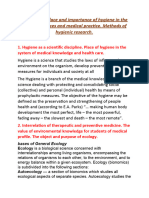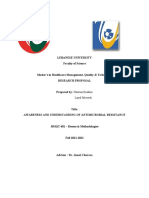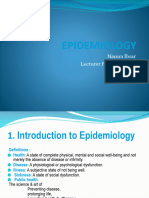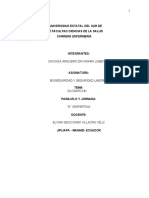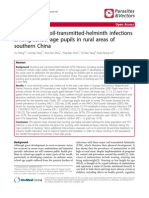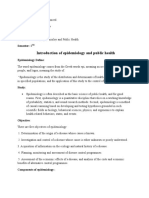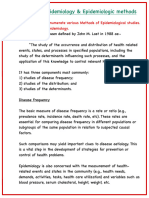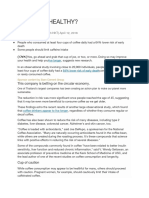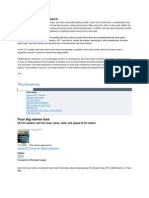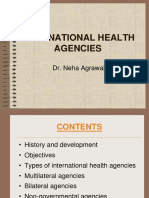0 ratings0% found this document useful (0 votes)
13 viewsBaye Temesgen One Health
Baye Temesgen One Health
Uploaded by
Lakew DestaThis document contains an individual assignment submitted by Baye Temesgen on the topic of One Health. It discusses 7 case studies as examples: 1) the 2014 Ebola virus outbreak in West Africa, 2) the emergence of avian influenza A(H7N9) in China in 2013, 3) the One Health approach to controlling zoonotic diseases in Sierra Leone, 4) Lyme disease and tick-borne illnesses in the US, 5) antibiotic resistance in animals and humans, 6) antimicrobial resistance in livestock production, and 7) lead poisoning in children. Each case study focuses on how the One Health approach integrates human, animal, and environmental health sectors.
Copyright:
© All Rights Reserved
Available Formats
Download as DOCX, PDF, TXT or read online from Scribd
Baye Temesgen One Health
Baye Temesgen One Health
Uploaded by
Lakew Desta0 ratings0% found this document useful (0 votes)
13 views4 pagesThis document contains an individual assignment submitted by Baye Temesgen on the topic of One Health. It discusses 7 case studies as examples: 1) the 2014 Ebola virus outbreak in West Africa, 2) the emergence of avian influenza A(H7N9) in China in 2013, 3) the One Health approach to controlling zoonotic diseases in Sierra Leone, 4) Lyme disease and tick-borne illnesses in the US, 5) antibiotic resistance in animals and humans, 6) antimicrobial resistance in livestock production, and 7) lead poisoning in children. Each case study focuses on how the One Health approach integrates human, animal, and environmental health sectors.
Original Description:
One Health assignment
Original Title
Baye Temesgen One Health
Copyright
© © All Rights Reserved
Available Formats
DOCX, PDF, TXT or read online from Scribd
Share this document
Did you find this document useful?
Is this content inappropriate?
This document contains an individual assignment submitted by Baye Temesgen on the topic of One Health. It discusses 7 case studies as examples: 1) the 2014 Ebola virus outbreak in West Africa, 2) the emergence of avian influenza A(H7N9) in China in 2013, 3) the One Health approach to controlling zoonotic diseases in Sierra Leone, 4) Lyme disease and tick-borne illnesses in the US, 5) antibiotic resistance in animals and humans, 6) antimicrobial resistance in livestock production, and 7) lead poisoning in children. Each case study focuses on how the One Health approach integrates human, animal, and environmental health sectors.
Copyright:
© All Rights Reserved
Available Formats
Download as DOCX, PDF, TXT or read online from Scribd
Download as docx, pdf, or txt
0 ratings0% found this document useful (0 votes)
13 views4 pagesBaye Temesgen One Health
Baye Temesgen One Health
Uploaded by
Lakew DestaThis document contains an individual assignment submitted by Baye Temesgen on the topic of One Health. It discusses 7 case studies as examples: 1) the 2014 Ebola virus outbreak in West Africa, 2) the emergence of avian influenza A(H7N9) in China in 2013, 3) the One Health approach to controlling zoonotic diseases in Sierra Leone, 4) Lyme disease and tick-borne illnesses in the US, 5) antibiotic resistance in animals and humans, 6) antimicrobial resistance in livestock production, and 7) lead poisoning in children. Each case study focuses on how the One Health approach integrates human, animal, and environmental health sectors.
Copyright:
© All Rights Reserved
Available Formats
Download as DOCX, PDF, TXT or read online from Scribd
Download as docx, pdf, or txt
You are on page 1of 4
ARBAMINCH UNIVERSITY
COLLEGE OF MEDICINE AND HEALTH SCIENCE
DEPARTMENT OF ENVIRONMENTAL HEALTH
INDIVIDUAL ASSIGNMENT
ON
ONE HEALTH
NAME: Baye Temesgen
ID NO: NSR/403/12
Sub.to…….Mr. Lakew Desta
Sub. Date…..14/09/2015 EC.
Select/find at least 3 case study example on One Health and discuss their core focus
area.
I. Case Study 1: The Ebola virus outbreak in West Africa
The outbreak of Ebola in West Africa in 2014 demonstrated the interconnectedness of
humans, animals, and the environment. Understanding the epidemiology of the disease
required a One-Health approach that integrated data from human, animal, and
environmental health sectors. This case study focused on the importance of cross-sectoral
collaboration and the need for more effective global health governance.
This case study also focused on the need for a One-Health approach to controlling
infectious diseases that can cross between animals and humans. Ebola virus is believed to
have originated from infected fruit bats and other wildlife, and the outbreak highlighted
the importance of coordinated efforts between human and animal health sectors in disease
detection, response, and prevention.
One-Health strategies included surveillance of animal health, training and capacity
building for animal healthcare workers, and joint planning and coordination between
human and animal health agencies.
II. Case Study: The case of avian influenza A(H7N9)
In 2013, a new strain of avian influenza A(H7N9) emerged in China, causing severe
respiratory illness and death in humans.
This case study examined the One-Health approach to understanding the epidemiology of
the disease, including the role of poultry as a reservoir for the virus and the potential for
human-to-human transmission.
The study highlighted the importance of cross-sectoral collaboration in disease
surveillance, prevention, and control efforts, including vaccination, biosecurity measures,
and public education.
III. Case study 3: Zoonotic Diseases in Sierra Leone
The One Health Approach to Zoonotic Diseases in Sierra Leone
The core focus area of this case study is the One Health approach to control and prevent
zoonotic diseases in Sierra Leone.
The country is vulnerable to outbreaks of diseases such as Ebola, Lassa fever, and avian
influenza due to its close proximity to wildlife and poor health and sanitation conditions.
The One Health approach in Sierra Leone involves collaboration between human health,
animal health, and environmental experts to identify and respond promptly to any
outbreaks of zoonotic diseases.
IV. Case Study 4: Lyme disease and tick-borne illnesses
Lyme disease is the most common vector-borne disease that is transmitted to humans
through the bite of infected ticks, in the U.S., with over 300,000 cases reported each year.
The One-Health approach to Lyme disease focuses on understanding the complex
interactions between humans, animals, and the environment that contribute to the spread
of the disease. The study explored the importance of surveillance and monitoring of
animal and environmental populations to identify high-risk areas and implement
prevention measures such as tick control and public education.
This case study emphasized the need for a One-Health approach to preventing and
controlling tick-borne diseases, which requires collaboration between public health,
veterinary, and wildlife agencies.
One-Health strategies included surveillance of tick populations and the diseases they
carry, identification and implementation of effective prevention measures such as tick
repellents and habitat modification, and education and training of healthcare
professionals and the general public to increase awareness of the risks and reduce the
incidence of tick-borne illnesses.
V. Case Study 5: Antibiotic resistance in animals and humans:
This case study focused on the link between the use of antibiotics in animals and the
development of antibiotic-resistant infections in humans, highlighting the need for a One-
Health approach to addressing this growing problem.
One-Health strategies included promoting responsible use of antibiotics in animal
agriculture, increasing surveillance and tracking of antibiotic-resistant infections in both
animals and humans, and implementing coordinated strategies for infection prevention
and control in healthcare settings.
This case study also emphasized the importance of public education and awareness to
promote responsible use of antibiotics and prevent the spread of resistant infections.
VI. Case Study 6: Antimicrobial resistance (AMR) in livestock
production
Antimicrobial resistance (AMR) is a growing public health threat globally, and the use of
antibiotics in livestock production has been identified as a driver of resistance.
This case study focused on the One-Health approach to addressing AMR in livestock,
emphasizing the importance of collaboration between human health, animal health, and
environmental sectors to promote rational use of antibiotics, implement surveillance and
control measures, and develop alternative strategies for disease prevention and treatment.
VII. Case Study 7: The case of lead poisoning in children
Lead poisoning is a preventable environmental health problem that affects millions of
children worldwide.
This case study explored the One-Health approach to lead poisoning prevention, focusing
on the integration of human health, animal health, and environmental factors in risk
assessment, surveillance, and control.
The study included efforts to promote lead-safe housing, reduce lead exposure in food
and drinking water, and develop alternative strategies for pest control.
You might also like
- Outbreak AssignmentDocument5 pagesOutbreak AssignmentEduard75% (8)
- Safety Data Sheet: Chemical Name Cas # Percent Classification NoteDocument7 pagesSafety Data Sheet: Chemical Name Cas # Percent Classification NoteLiliana Beru0% (1)
- Reflection Paper EcheDocument2 pagesReflection Paper Echeceline dela cruz100% (1)
- 1 - EpidemiologyDocument26 pages1 - Epidemiologyhemihema75% (4)
- Manual of Infection Prevention and Control (PDFDrive)Document399 pagesManual of Infection Prevention and Control (PDFDrive)அந்தோணி சாமி100% (2)
- DR Nilukshi Perera Consultant HaematologistDocument68 pagesDR Nilukshi Perera Consultant HaematologistThaveeshaLindsayWhiteNo ratings yet
- Basics of Food Safety: An OverviewDocument33 pagesBasics of Food Safety: An OverviewShahrukh Ghulam NabiNo ratings yet
- A Modern History of Psychiatric-Mental Health Nursing PDFDocument7 pagesA Modern History of Psychiatric-Mental Health Nursing PDFdedisukasusuNo ratings yet
- Asyment 1Document8 pagesAsyment 1Lakew DestaNo ratings yet
- EsubalewDocument7 pagesEsubalewLakew DestaNo ratings yet
- Study Notes 3Document2 pagesStudy Notes 3AfriantoNo ratings yet
- Epidemiology 2021Document73 pagesEpidemiology 2021Lennon T MuchanganiNo ratings yet
- BPH 122 General ZoologyDocument30 pagesBPH 122 General Zoologyanjelopaul2017No ratings yet
- Global Health Security and The Role of One HealthDocument9 pagesGlobal Health Security and The Role of One Healthdecastro.thomasNo ratings yet
- One Health IntroductionDocument20 pagesOne Health Introductiondecastro.thomasNo ratings yet
- Chapter 1Document48 pagesChapter 1placalus nimbusNo ratings yet
- ResearchDocument9 pagesResearchfrancinemeneken74No ratings yet
- Effects of Communicable Disease Among Secondary School Student in Port Harcourt Local Government Area of Rivers State (Document68 pagesEffects of Communicable Disease Among Secondary School Student in Port Harcourt Local Government Area of Rivers State (chindajoseph9No ratings yet
- Intro To PHPDocument18 pagesIntro To PHPHajra MirzaNo ratings yet
- Antimicrobial Resistance Surveillance in Ethiopia: Implementation Experiences and Lessons LearnedDocument4 pagesAntimicrobial Resistance Surveillance in Ethiopia: Implementation Experiences and Lessons LearnedRajihaNo ratings yet
- Unit - 4 Environmental and Occupational EpidemiologyDocument47 pagesUnit - 4 Environmental and Occupational Epidemiologyravdeep146chahalNo ratings yet
- EpidemiologyDocument7 pagesEpidemiologyInoxcent Moon100% (1)
- AVMA - One Health PDFDocument9 pagesAVMA - One Health PDFVinda MaulinaNo ratings yet
- Introduction of EpidemiologyDocument30 pagesIntroduction of Epidemiologymahfuj.ytpNo ratings yet
- Zambia Study Dec 2019Document9 pagesZambia Study Dec 2019AbiodunOlaiyaPaulNo ratings yet
- ZOONESESDocument72 pagesZOONESESJash FloresNo ratings yet
- EpidemiologyDocument18 pagesEpidemiologyRose Jean C. OtodNo ratings yet
- Unit 6: Risk, Exposure, and Health: SectionsDocument33 pagesUnit 6: Risk, Exposure, and Health: Sectionsapi-286231291No ratings yet
- UTS Soal 2Document2 pagesUTS Soal 2Tataauliya IntanNo ratings yet
- Disaster Nursing SAS Session 14Document6 pagesDisaster Nursing SAS Session 14Niceniadas CaraballeNo ratings yet
- Week 1 - Lecture 1Document20 pagesWeek 1 - Lecture 1M HossainNo ratings yet
- MJCU_Volume 87_Issue September_Pages 3117-3125Document9 pagesMJCU_Volume 87_Issue September_Pages 3117-3125muqhni al-ulaNo ratings yet
- Case 1Document8 pagesCase 1Lakew DestaNo ratings yet
- ThesisDocument5 pagesThesisbalocotiffanyNo ratings yet
- EPI Lecture Note April 2005, YemaneDocument132 pagesEPI Lecture Note April 2005, YemaneGetahun Tekle100% (2)
- CHN 2 NUR 1214 Week 2 Module 2.1Document11 pagesCHN 2 NUR 1214 Week 2 Module 2.1Lorraine Jazmine AquinoNo ratings yet
- Zoonotic Diseases and One HealthDocument6 pagesZoonotic Diseases and One Healthruechihamba13No ratings yet
- Jurnal Reading AMRDocument49 pagesJurnal Reading AMRLoudry Amsal EGNo ratings yet
- 7 (1)Document24 pages7 (1)aryaditya3060No ratings yet
- The Influence of Veterinary Epidemiology On PublicDocument12 pagesThe Influence of Veterinary Epidemiology On PublicFlavio VallejoNo ratings yet
- Search For Better Health Assessment TaskDocument3 pagesSearch For Better Health Assessment TaskJoseph WongNo ratings yet
- Effects of Water, Sanitation and Hygiene (WASH) Education On Childhood Intestinal Parasitic Infections in Rural Dembiya, Northwest Ethiopia An Uncontrolled (2019) Zemi PDFDocument8 pagesEffects of Water, Sanitation and Hygiene (WASH) Education On Childhood Intestinal Parasitic Infections in Rural Dembiya, Northwest Ethiopia An Uncontrolled (2019) Zemi PDFKim NichiNo ratings yet
- Components of Health ServicesDocument74 pagesComponents of Health Servicessmaji5693No ratings yet
- Epidem. Lecture 1 & 2Document18 pagesEpidem. Lecture 1 & 2sajad abasew100% (1)
- Literature Review CD HLTH 634Document8 pagesLiterature Review CD HLTH 634api-518080609No ratings yet
- Lesson 1Document71 pagesLesson 1DEREK DARRELNo ratings yet
- Infectious Disease Management:: WWW - Immunise.health - Gov.auDocument2 pagesInfectious Disease Management:: WWW - Immunise.health - Gov.auCassieJenkinsNo ratings yet
- Topic 1. The Place and Importance of Hygiene in The Medical Sciences and MedicalDocument8 pagesTopic 1. The Place and Importance of Hygiene in The Medical Sciences and MedicalManar BehiNo ratings yet
- Antimicrobial ResistenceDocument23 pagesAntimicrobial Resistencelayal mroweh100% (1)
- One Health Info SheetDocument4 pagesOne Health Info SheetAslam MuhammadNo ratings yet
- Treat Pneumonia With The Wonder DrugsDocument3 pagesTreat Pneumonia With The Wonder DrugsbobbyramakantNo ratings yet
- AMR Action Plan - Role of AcademiaDocument55 pagesAMR Action Plan - Role of AcademiaShonit Sharma100% (1)
- Effect of Hygiene Guidelines On Knowledge, Attitudes, and Practices of Food Handlers at University CafeteriasDocument12 pagesEffect of Hygiene Guidelines On Knowledge, Attitudes, and Practices of Food Handlers at University CafeteriasOSCAR DE JESUS FLORESNo ratings yet
- Research ArticleDocument13 pagesResearch ArticleDENNYNo ratings yet
- EpidemiologyDocument10 pagesEpidemiologyMUTHUKUMARANNo ratings yet
- Research Review FormDocument2 pagesResearch Review FormjrbvxfvjhjNo ratings yet
- EpidemiologyDocument36 pagesEpidemiologyabubakar251228No ratings yet
- Bioseguridad - Glosario #1 - InglesDocument13 pagesBioseguridad - Glosario #1 - InglesLisbeth ArgueroNo ratings yet
- Foundations of EpidemiologyDocument106 pagesFoundations of EpidemiologySudaysi AbdisalamNo ratings yet
- Stunting and Soil-Transmitted-Helminth Infections Among School-Age Pupils in Rural Areas of Southern ChinaDocument6 pagesStunting and Soil-Transmitted-Helminth Infections Among School-Age Pupils in Rural Areas of Southern ChinaRohit GehiNo ratings yet
- Introduction of Epidemiology and Public Health - (Roll No.02)Document6 pagesIntroduction of Epidemiology and Public Health - (Roll No.02)HeroNo ratings yet
- Newer & Emerging Vaccine SynopsisDocument13 pagesNewer & Emerging Vaccine SynopsisShikhar SinghNo ratings yet
- Principles of Epidemiology & Epidemiologic MethodsDocument62 pagesPrinciples of Epidemiology & Epidemiologic MethodsMonish NavaneethanNo ratings yet
- Hubungan Caring Perawat Dengan Kepuasan Pasien RawDocument6 pagesHubungan Caring Perawat Dengan Kepuasan Pasien RawNISANo ratings yet
- Providing Prevention Education About Child Sexual Abuse To ParentDocument140 pagesProviding Prevention Education About Child Sexual Abuse To Parentnishikanta tareniaNo ratings yet
- Medical Fitness Certificate For YourDocument4 pagesMedical Fitness Certificate For Yourvivekkumar s0% (1)
- Evaluation of Factors That Influence High Morbidity Rate in Pregnant Women Attending Antenatal Care at Kampala International University-Teaching Hospital (KIUTH), Bushenyi District, Uganda.Document13 pagesEvaluation of Factors That Influence High Morbidity Rate in Pregnant Women Attending Antenatal Care at Kampala International University-Teaching Hospital (KIUTH), Bushenyi District, Uganda.KIU PUBLICATION AND EXTENSIONNo ratings yet
- K To 12 CurriculumDocument75 pagesK To 12 Curriculumrevertlyn88% (8)
- Anuncio de Empleo Medico en InglesDocument1 pageAnuncio de Empleo Medico en InglesRoberto AlvaradoNo ratings yet
- Is Coffee Healthy?: by Lisa Drayer, CNNDocument4 pagesIs Coffee Healthy?: by Lisa Drayer, CNNAlilah BarizahNo ratings yet
- Jurnal Keperawatan Gerontik InternasionalDocument12 pagesJurnal Keperawatan Gerontik InternasionalRiie Napabii DuatigasembilandelapanNo ratings yet
- Positive Thinking - The Power of A Positive MindsetDocument2 pagesPositive Thinking - The Power of A Positive Mindsetvictorrr.hustlesNo ratings yet
- Teenage Pregnancy Presentation1Document11 pagesTeenage Pregnancy Presentation1Roy D. DaguploNo ratings yet
- Preview of "year4MicrosoftWord-MBBSPhase4HANDBOOK2010 - 2011FinalV2-2010-2011.pdf"Document11 pagesPreview of "year4MicrosoftWord-MBBSPhase4HANDBOOK2010 - 2011FinalV2-2010-2011.pdf"bosun88No ratings yet
- Dawn Viveash CVDocument4 pagesDawn Viveash CVapi-275311205No ratings yet
- Health Education PPT WEEK 2Document27 pagesHealth Education PPT WEEK 2maryjoymadredijo173No ratings yet
- Hypnosis Principles and Applications. An Adjunct To Anesthesia - M.R. EslingerDocument8 pagesHypnosis Principles and Applications. An Adjunct To Anesthesia - M.R. EslingerNiky GiaccioNo ratings yet
- OMEPRAZOLEDocument5 pagesOMEPRAZOLEElizabeth Ivory Chua100% (1)
- TATA ReportDocument9 pagesTATA ReportJahnvi KumarNo ratings yet
- Mri ReportDocument49 pagesMri ReportPaulo Henrique Vizoná de OliveiraNo ratings yet
- Fast Food Industry ResearchDocument13 pagesFast Food Industry ResearchNaa Okaikor OkineNo ratings yet
- Health Talk On Kangaroo Mother CareDocument17 pagesHealth Talk On Kangaroo Mother CareArchita SharmaNo ratings yet
- Case Write Up Ent - Right PerichondritisDocument10 pagesCase Write Up Ent - Right PerichondritisS2129127 STUDENTNo ratings yet
- International Health Agencies: Dr. Neha AgrawalDocument96 pagesInternational Health Agencies: Dr. Neha Agrawal121816601027 NONGTHOMBAM NGANTHOI DEVINo ratings yet
- Resume 2017Document2 pagesResume 2017api-364399974No ratings yet
- 100 Ab Workouts by DarebeeDocument40 pages100 Ab Workouts by DarebeeTurtle HermitNo ratings yet
- Hubungan Intensitas Kebisingan Dengan Tekanan Darah Sistolik Dan Diastolik Pada Pekerja Pertambangan Pasir Dan Batu Pt. X Rowosari, SemarangDocument10 pagesHubungan Intensitas Kebisingan Dengan Tekanan Darah Sistolik Dan Diastolik Pada Pekerja Pertambangan Pasir Dan Batu Pt. X Rowosari, SemarangIvanalia Miko SalsabilaNo ratings yet
- Safety Data Sheet: 1. IdentificationDocument7 pagesSafety Data Sheet: 1. IdentificationRacha KhalilNo ratings yet
- Olbas Oil PilDocument4 pagesOlbas Oil PilSalmanNo ratings yet



